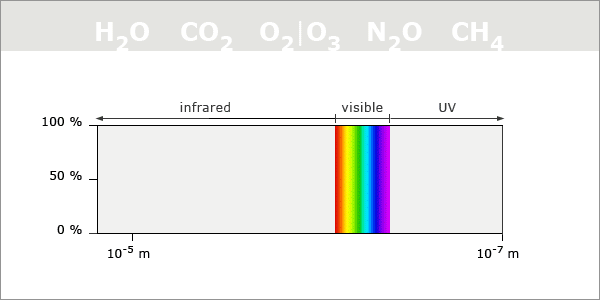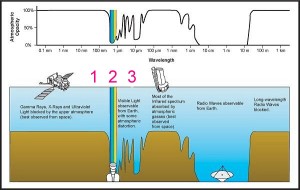|
|
 |
|
|
|
 |
| |
|
|
 |
Lower Atmosphere
Read more |
The Earth's radiation budget and the Greenhouse Effect
The climate system is driven by the energy from the Sun. Only a certain fraction of this energy reaches the surface of the Earth and causes warming. The rest of the solar energy is reflected back into space or absorbed by the atmosphere. In this section we look at how the Earth's radiation system works.
|
|
|
|
|
 |
a) When we look at the radiation budget of the Earth, we can divide the system into three parts:
1) outer space
2) our atmosphere
3) the surface of the Earth
In each part of the system the amount of energy coming in equals the amount of the energy leaving. If this wasn't the case, one part of the system would become either warmer and warmer or colder and colder over time and this isn't happening. So the system is in equilibrium (balance).
b) Greenhouse gases do NOT produce energy. They help to generate an equilibrium state where the surface layer of the atmosphere is unusually warm.
|
 |
 |
 |
|
1. The global radiation budget as published in IPCC TAR Chap. 1.2.1. In the following sections we try to understand the different energy transport systems which govern our climate. Please click to enlarge! (40 K)
|
|
|
The reality is a bit more complicated since the oceans react very slowly to changes in temperature. So if the temperature rises as a result of global warming, the atmospheric temperature increases rapidly but it takes much longer for the oceans to heat up. One full turnover of the ocean water takes about 1000 years. This means that until the oceans heat up fully, the Earth is in a state of disequilibrium. Therefore, the radiation budget shown above has an uncertainty of 10 - 20%. In the following sections we assume that the equilibrium situation has been reached and the Earth system is in balance.
|
 |
 |
|
2. Greenhouse gases keep the planetary boundary layer warm in the same way as our clothes do in winter. Adapted from fashion 3sat online.
|
|
 |
The role of greenhouse gases
We wear a jumper on a cold day to keep us warm. However, the jumper doesn't make the air any warmer or make our body produce more energy and the jumper doesn't produce energy itself! It simply sends part of the energy coming from our body back towards our skin causing a warm layer of air between the jumper and ourselves. This is exactly what greenhouse gases do. An increasing greenhouse effect doesn't mean that more energy comes from the Sun but that a larger proportion of the energy coming from the Earth's surface is sent back towards the surface allowing more heat to accumulate before it is released back into space.
|
Understanding the energy budget
We measure the energy transferred into, or emitted from, a part of the system in watts per square metre (W m-2). First, let us check that that the same amount of energy comes in and goes out of the system (here we simplify by leaving out the retarding effect of the oceans):
342 W m-2 of energy enters our atmosphere directly from the Sun. About 30% of this solar energy (107 W m-2) is directly reflected back into space either from the clouds or from the surface of the Earth. This fraction of sunlight reflected directly back to space is known as the Earth's albedo, so the Earth has an average albedo of 0.3. Clouds and polar ice caps are the most efficient reflectors of solar radiation directly back into space.
Definition of albedo: The ratio of the light reflected by a body to the light received by it. Albedo values range from 0 (pitch black) to 1 (perfect reflector).
|
 |
 |
 |
|
3. The energy balance for outer space, our atmosphere and the Earth's surface. Everything is in equilibrium. Solar radiation is shown in yellow and long wave infra-red radiation in red. A certain fraction of the energy is also needed for evaporation of water and thermal transfer.
Image: Elmar Uherek, data from IPCC TAR. Please click to enlarge (90 K).
|
|
|
The remaining 235 W m-2 of energy from the Sun interacts either with the atmosphere or with the Earth's surface. It then returns to space as long wave infra-red radiation.
|
 |
 |
|
4. A reduced view of the Earth's radiation budget (reflection excluded) and an illustration of the atmospheric window. Image by Elmar Uherek.
Please click to entlarge!
|
|
 |
When we look at the radiation budget, we see that the surface of the Earth absorbs more energy (492 W m-2) than the total amount of energy coming from the Sun. If the system is in equilibrium this can't be true! So how does this happen? The atmosphere can either re-emit the energy it has absorbed back into space or send it back to the surface of the Earth. The presence of greenhouse gases in the atmosphere allows energy to be reflected back to the Earth making it appear that the system is unbalanced.
The atmospheric window
Only 40 W m-2 of energy is directly emitted as long wave infra-red radiation from the Earth's surface into space.
|
 |
 |
|
5. The model of a greenhouse. Illustration: Elmar Uherek.
|
|
 |
Only a small amount of the infra-red radiation emitted from the surface of the Earth can escape directly into space. Most is absorbed by the greenhouse gases present in the atmosphere. There are a few gaps in the overlapping absorption spectra of water (which absorbs roughly 60%), carbon dioxide, methane, nitrous oxide, ozone and the other greenhouse gases where infra-red radiation can't be absorbed. The most important gaps are known as the atmospheric window. Put very simply, the infrared radiation can disappear into space like heat does through a window in the roof of a greenhouse.
|
|
The analogy of the greenhouse gases to the glass of a greenhouse is not perfect. The gases interact with light, while the glass is a solid barrier which also prevents convection so that heat is retained.
|
 |
 |
|
6. Where do which gases absorb?
Only a small fraction of the (theoretically calculated) radiation emitted from the Earth can escape into space. The rest is taken up by greenhouse gases. Each of these gases absorbs different wavelengths and energies in the electromagnetic spectrum of visible and not visible (UV, infrared) light.
Animation: Anja Kaiser © ESPERE
|
 |
 |
|
Picture from NASA / IPAC. Please click to enlarge! (80 K)
|
|
 |
7. How much radiation passes through the atmosphere at each wave length?
The interaction of electromagnetic waves with the atmosphere shows that it is opaque (not transparent) in certain areas of the light range.
In the image above, these parts are shown in brown. Of special interest is the near ultra-violet radiation (1), the visible light (2) and the near infra-red radiation (3). Ozone absorbs in the range (1) and makes the atmosphere opaque for dangerous UV-B radiation from the sun. Next to it, visible light (2) reaches the ground and lights our days and heats the Earth's surface. Infra-red radiation (3) from the Earth (see image above) can go back to space, but only in the areas which are not blocked. Firstly water and then carbon dioxide make parts of the infrared range opaque for the radiation from the Earth (greenhouse effect). If other gases (O3, CH4, N2O) absorb in the remaining 'atmospheric window' (see spectra above), they are very efficient greenhouse gases. |
About this page:
author: Dr. Elmar Uherek - MPI for Chemistry, Mainz
scientific reviewing: Dr. Benedikt Steil - MPI for Chemistry, Mainz - 2004-05-16
educational proofreading: Michael Seesing - Uni Duisburg - 2003-07-02
last published: 2004-06-17
|
|
 |
|







